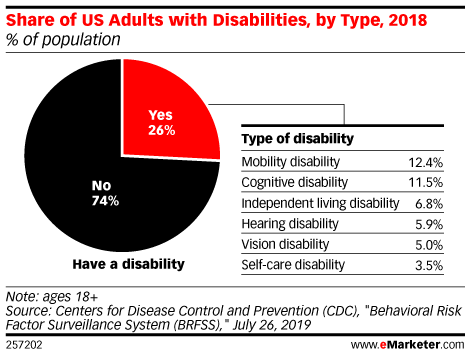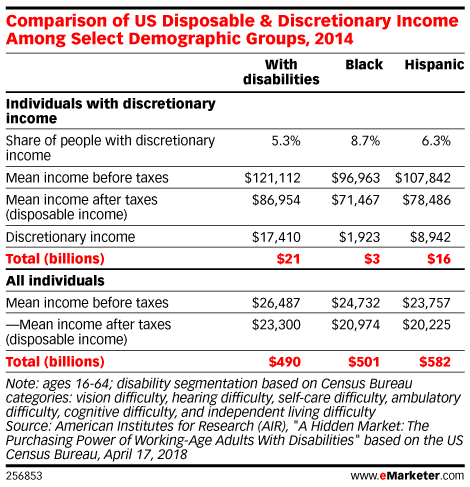
Did you know people with disabilities make up the nation’s largest minority? With more than two in every five adults ages 65 and older (43.8%), more than one in four women (27.2%), and nearly two in five non-Hispanic Native Americans or Alaska Natives, people with disabilities make up a sizable segment of the U.S. population. However, people with disabilities are routinely excluded from, and inaccurately portrayed in, advertising and media. In fact, an eMarketer survey cited just 15% of marketers worldwide could recall people with physical or mental disabilities being portrayed positively in their recent campaigns – making the nation’s largest minority the least represented. See the problem?
How many U.S. adults have a disability?
According to statistics from the Centers for Disease Control and Prevention (CDC), more than 67 million adults in the U.S. — or 26% of the population — reported living with at least one type of disability. Mobility disabilities are most common, closely followed by cognitive disabilities.

How underrepresented are they?
Nielsen set out to examine the lack of representation of people with disabilities in TV ads. Their study looked at 450,000 primetime ads on broadcast and cable TV during February of this year and found that just 1% of those ads showed someone with a disability. And of the small fraction of commercials considered “disability-inclusive,” nearly half of ad spend came from pharmaceutical and healthcare companies.
How much purchasing power do people with disabilities yield?
The American Institutes for Research (AIR) reported that the roughly 20 million U.S. working-age adults with disabilities — not including their extended families, support networks, and allies — had a collective after-tax disposable income of about $490 billion. This was close to the collective after-tax disposable incomes of Black consumers ($501 billion) and Hispanic consumers ($582 billion).

How can we make campaigns more inclusive?
Supporting people with disabilities should be a constant commitment. Of course, the anniversary of the Americans with Disabilities Act and Disability Employment Awareness Month are celebrated in July and October respectively. But if you’re only showing meaningful representation in these two months, your efforts could come across as opportunistic and empty. Make your campaigns more inclusive by taking these four tips.
- Use actual individuals with disabilities – not actors. Craig Radford, vice president of strategy and business development at Communication Service for the Deaf (CSD), said he’s seen several ads that included amputees, but they were just models whose legs had been removed during photo editing. Hopefully it goes without saying, but this is a hard no.
- Present people with disabilities in a positive way. Show people with disabilities in everyday situations, while expressing themselves, rather than having another person (such as a caregiver or family member) forming opinions for them. For example, Christina Mallon, global head of inclusive design and digital accessibility at Wunderman Thompson, said, “We don’t want to see campaigns that say, ‘Look what we did for them,’ or that depict situations where there’s a giver and a receiver, and the person with the disability is the receiver.” Show them as capable individuals with a variety of personalities, with romantic interests, and with many levels of social skills and intelligence.
- Be thoughtful with word choices. Proper terminology changes over time. To make sure you’re conveying respect and integrity, explore resources like this writing guide and this terminology guide.
- Ensure accessibility. Accessibility is key to disability-inclusive marketing. And despite legal requirements under the Americans with Disabilities Act (ADA), a surprisingly large number of businesses still haven’t taken the basic steps to optimize their websites and other communications for assistive technologies or make their content available in alternate formats. Thus, as you create new content, be mindful of whether ALL people can consume it. According to Google, you can ensure accessibility by:
- Using a responsive design to ensure sizing and functionality across all desktop, laptop, tablet and mobile devices
- Making content compatible with screen readers by avoid blinking, flickering, flashing, or moving content; providing transcripts for all audio and video content; ensuring there’s sufficient color contrast
- Using descriptive headlines and subheads in copy; avoiding jargon-packed sentences; being mindful of abstract language, sarcasm, metaphors, and jokes; re-examining language with direction or sensory characteristics
- Making hyperlinks provide enough of a description for those using an assistive screen reader to understand where the link goes
- Providing captions and transcripts for TV and video; allowing the user to start and stop the content; ensuring the start and stop buttons are easy to navigate and read properly by screen readers; adding audio descriptions.
- Having wheelchair-accessible pathways at events; adding Communication Access Realtime Translation (CART) captioning; providing sign language interpreters; providing audio descriptions for content
To learn more about inclusive advertising – and advertising in general – subscribe to our blog. Our experts share insights just like these ones, as often as we can.























